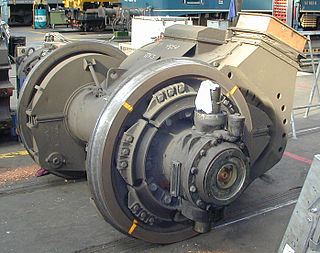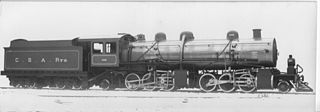
A locomotive or engine is a rail transport vehicle that provides the motive power for a train. If a locomotive is capable of carrying a payload, it is usually rather referred to as a multiple unit, motor coach, railcar or power car; the use of these self-propelled vehicles is increasingly common for passenger trains, but rare for freight.

A tank locomotive or tank engine is a steam locomotive that carries its water in one or more on-board water tanks, instead of a more traditional tender. Most tank engines also have bunkers to hold fuel; in a tender-tank locomotive a tender holds some or all of the fuel, and may hold some water also.
As used in mechanical engineering, the term tractive force can either refer to the total traction a vehicle exerts on a surface, or the amount of the total traction that is parallel to the direction of motion.

On a steam locomotive, a driving wheel is a powered wheel which is driven by the locomotive's pistons. On a conventional, non-articulated locomotive, the driving wheels are all coupled together with side rods ; normally one pair is directly driven by the main rod which is connected to the end of the piston rod; power is transmitted to the others through the side rods.

In both road and rail vehicles, the wheelbase is the horizontal distance between the centers of the front and rear wheels. For road vehicles with more than two axles, the wheelbase is the distance between the steering (front) axle and the centerpoint of the driving axle group. In the case of a tri-axle truck, the wheelbase would be the distance between the steering axle and a point midway between the two rear axles.

Under the Whyte notation for the classification of steam locomotives, 4-2-0 represents the wheel arrangement of four leading wheels on two axles, two powered driving wheels on one axle and no trailing wheels. This type of locomotive is often called a Jervis type, the name of the original designer.

In the Whyte notation, a 6-2-0 is a railroad steam locomotive that has an unpowered three-axle leading truck followed by a single powered driving axle. This wheel arrangement is associated with the Crampton locomotive type, and in the USA the single class were sometimes referred to as Cramptons.

Under the Whyte notation for the classification of steam locomotives by wheel arrangement, a 2-6-6-2 is a locomotive with one pair of unpowered leading wheels, followed by two sets of three pairs of powered driving wheels and one pair of trailing wheels. The wheel arrangement was principally used on Mallet-type articulated locomotives, although some tank locomotive examples were also built. A Garratt type locomotive with the same wheel arrangement is designated 2-6-0+0-6-2.
The axle load of a wheeled vehicle is the total weight bearing on the roadway for all wheels connected to a given axle. Axle load is an important design consideration in the engineering of roadways and railways, as both are designed to tolerate a maximum weight-per-axle ; exceeding the maximum rated axle load will cause damage to the roadway or rail tracks.

An adhesion railway relies on adhesion traction to move the train. Adhesion traction is the friction between the drive wheels and the steel rail. The term "adhesion railway" is used only when it is necessary to distinguish adhesion railways from railways moved by other means, such as by a stationary engine pulling on a cable attached to the cars or by railways that are moved by a pinion meshing with a rack.

A coupling rod or side rod connects the driving wheels of a locomotive. Steam locomotives in particular usually have them, but some diesel and electric locomotives, especially older ones and shunters, also have them. The coupling rods transfer the power of drive to all wheels.

The Great Western Railway (GWR) 4300 Class is a class of 2-6-0 (mogul) steam locomotives, designed by G.J. Churchward for mixed traffic duties. 342 were built from 1911–1932.
In rail terminology, the hammer blow is a vertical force which alternately adds to and subtracts from the locomotive's weight on a wheel. It is transferred to the track by the driving wheels of many steam locomotives. It is an out-of-balance force on the wheel. It is the result of a compromise when a locomotive's wheels are unbalanced to off-set horizontal reciprocating masses, such as connecting rods and pistons, to improve the ride. The hammer blow may cause damage to the locomotive and track if the wheel/rail force is high enough. 'Dynamic augment' is the US term for the same force.
Locomotive wheelslip is an event that affects railway motive power usually when starting from stationary, but can also affect an engine in motion.
A carrying wheel on a steam locomotive is a wheel that is not driven; i.e., it is uncoupled and can run freely, unlike a coupled or driving wheel. It is also described as a running wheel and their axle may be called a carrying axle. A carrying wheel is referred to as leading wheel if it is at the front, or a trailing wheel if it is at the rear of the locomotive.

The South African Railways Class 21 2-10-4 of 1937 was a steam locomotive.

The South African Railways Class NG G11 2-6-0+0-6-2 of 1919 was a narrow gauge steam locomotive.
A divided drive locomotive is a steam locomotive that divides the driving force on its wheels by using different cylinders to power different pairs of driving wheels in order to give better weight distribution and reduce "hammer blow" which can be damaging to the track, or else to enable the wider spacing of the driving wheels to accommodate a larger firebox.

A train wheel or rail wheel is a type of wheel specially designed for use on railway tracks. The wheel acts as a rolling component, typically pushed onto an axle and mounted directly on a railway carriage or locomotive, or indirectly on a bogie, also called a truck. The powered wheels under the locomotive are called driving wheels. Wheels are initially cast or forged and then heat-treated to have a specific hardness. New wheels are machined using a lathe to a standardized shape, called a profile, before being installed onto an axle. All wheel profiles are regularly checked to ensure proper interaction between the wheel and the rail. Incorrectly profiled wheels and worn wheels can increase rolling resistance, reduce energy efficiency and may even cause a derailment.

The South African type FT tender was a steam locomotive tender.













